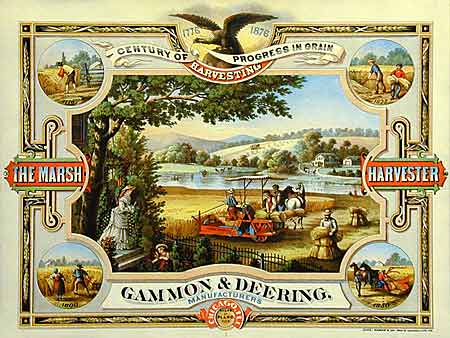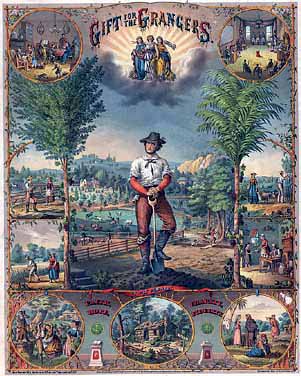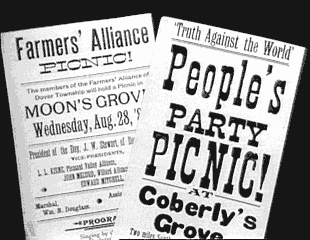Farmers Protest, 1870s-1890s

Printed by Charles Shober & Co. (Chicago) for Gammon & Deering (Chicago)
Inset views of obsolete harvesting technologies helped portray the Marsh Harvester as the pinnacle of mechanical genius and the foundation of rural prosperity. The Marsh Harvester itself would be superseded within a decade by the twine binder. http://www.wisconsinhistory.org/artofthedraw/poster7.htm
Beginning in the 1870s, worsening conditions in rural America caused many people to abandon their farms. At the same time, changes in farming practices and the agricultural marketplace made farmers more dependent on commercial decisions made by big-city businessmen. In reaction to these trends, farmers began to take political action--first with the Grange Movement, then the Farmers' Alliance and finally the emergence of the national Populist movement in the 1890s.
The populist movement was the most important and radical third party ever established in this country. It was the last substantial effort at structural alteration of hierarchical economic forms in modern America. It was, in fact, America's greatest mass-democratic movement.

The Grange (Today's Grange Organization)
The first organized effort to address general agricultural problems was the Granger movement. Launched in 1867 by employees of the U.S. Department of Agriculture, the Granges focused initially on social activities to counter the isolation most farm families encountered. Women's participation was actively encouraged. Spurred by the Panic of 1873, the Grange soon grew to 20,000 chapters and one-and-a-half million members.
Although most of them ultimately failed, the Granges set up their own marketing systems, stores, processing plants, factories and cooperatives. The movement also enjoyed some political success during the 1870s. A few states passed "Granger laws," limiting railroad and warehouse fees.
Wabash, St. Louis & Pacific Railroad v. Illinois (1887): http://historymatters.gmu.edu/d/5746/
The Supreme Court reversed its position initially put forth in Munn v. Illinois, by holding that Illinois legislation enacted to regulate railroad rates interfered with the Congress's ability to exercise its authority over interstate commerce. This decision ended the brief era of state railroad regulation. Congress passed the Interstate Commerce Act in 1887.
The Farmers' Alliance (The Farmers' Alliance Insurance Company still exists)
By 1880 the Grange movement began to decline, replaced by the Farmers' Alliances. By 1890 the Alliance movements had members from New York to California totaling about 1.5 million. A parallel African-American organization, the Colored Farmers National Alliance, numbered over a million members.
From the beginning, the Farmers' Alliances were political organizations with elaborate economic programs. According to one early platform, its purpose was to "unite the farmers of America for their protection against class legislation and the encroachments of concentrated capital." Their program also called for the regulation -- if not the outright nationalization -- of the railroads; currency inflation to provide debt relief; the lowering of the tariff; and the establishment of government-owned storehouses and low-interest lending facilities.
During the late 1880s a series of droughts devastated the western Great Plains. Western Kansas lost half its population during a four-year span. To make matters worse, the McKinley Tariff of 1890 was one of the highest the country had ever seen.

The Populist Party (The 1892 Omaha Platform)
By 1890 the level of agrarian distress was at an all-time high. Working with sympathetic Democrats in the South or small third parties in the West, the Farmer's Alliance made a push for political power. From these elements, a third political party, known as the Populist Party, emerged. Never before in American politics had there been anything like the Populist fervor that swept the prairies and cotton lands. The elections of 1890 brought the new party into power in a dozen Southern and Western states, and sent a score of Populist senators and representatives to Congress.
Its first convention was in 1892, when delegates from farm, labor and reform organizations met in Omaha, Nebraska, determined at last to make their mark on a U.S. political system they viewed as hopelessly corrupted by the monied interests of the industrial and commercial trusts. Their platform stated:
We are met, in the midst of a nation brought to the verge of moral, political and material ruin. Corruption dominates the ballot-box, the legislatures, the Congress, and touches even the ermine of the bench [courts].... From the same prolific womb of governmental injustice we breed the two great classes -- tramps and millionaires.
They stated six principal demands:
- A permanent union of all working classes
- Wealth for the workers
- Government ownership of railroads
- Government ownership of all communications systems
- More flexible and fair distribution of the national currency
- No more ownership of land by those who do not actually use it
As it turned out, the Populists' secondary, less radical demands came into law within twenty years: a secret ballot, a graduated income tax, and direct election of senators.
